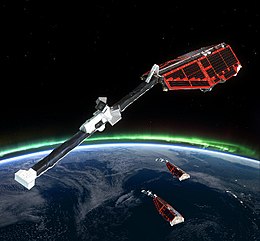Swarm (ESA mission)

Artist's view of the three Swarm spacecraft
|
|
| Mission type | Earth's magnetic field observation |
|---|---|
| Operator | ESA |
| COSPAR ID |
SWARM A: 2013-067B SWARM B: 2013-067A SWARM C: 2013-067C |
| SATCAT no. |
SWARM A: 39452 SWARM B: 39451 SWARM C: 39453 |
| Website | eoPortal - SWARM |
| Mission duration | 4 years (planned) Elapsed: 3 years, 5 months, 2 days |
| Spacecraft properties | |
| Manufacturer | Astrium |
| Launch mass | 468 kilograms (1,032 lb) |
| Dry mass | 369 kilograms (814 lb) |
| Dimensions | 9.1 m × 1.5 m × 0.85 m |
| Power | 608 watts |
| Start of mission | |
| Launch date | 22 November 2013, 12:02:29 UTC |
| Rocket | Rokot/Briz-KM |
| Launch site | Plesetsk Site 133/3 |
| Contractor | Eurockot |
| Orbital parameters | |
| Reference system | Geocentric |
| Regime | Polar orbit |
| Perigee |
SWARM A: ≤460 km (290 mi) SWARM C: ≤460 km (290 mi) SWARM B: ≤530 km (330 mi) |
| Apogee |
SWARM A: ≤460 km (290 mi) SWARM C: ≤460 km (290 mi) SWARM B: ≤530 km (330 mi) |
| Inclination |
SWARM A: 87.4° SWARM C: 87.4° SWARM B: 88° |
| Mean motion | 15 |
| Epoch | Planned |
| Transponders | |
| Band | S Band |
| Frequency | 2 GHz |
| Bandwidth | 6Mbit/s download 4kbit/s upload |
| Instruments | |
|
VFM: Vector Field Magnetometer ASM: Absolute Scalar Magnetometer EFI: Electric Field Instrument ACC: Accelerometer LRR: Laser Range Reflector |
|
|
|
|
Swarm is a European Space Agency (ESA) mission to study the Earth's magnetic field. High-precision and high-resolution measurements of the strength, direction and variations of the Earth's magnetic field, complemented by precise navigation, accelerometer and electric field measurements, will provide data for modelling the geomagnetic field and its interaction with other physical aspects of the Earth system. The results offer a view of the inside of the Earth from space, enabling the composition and processes of the interior to be studied in detail and increase our knowledge of atmospheric processes and ocean circulation patterns that affect climate and weather.
The overall objective of the Swarm mission is to build on the experience from the Ørsted and CHAMP missions and to provide the best ever survey of the geomagnetic field (multi-point measurements) and its temporal evolution, to gain new insights into the Earth system by improving our understanding of the Earth's interior and climate.
The Swarm constellation consists of three satellites (Alpha, Bravo & Charlie) placed in two different polar orbits, two flying side by side at an altitude of 450 km (280 mi) and a third at an altitude of 530 km (330 mi). The launch was delayed and rescheduled to 12:02:29 UTC (7:02:29 a.m. EST) on 22 November 2013, from Plesetsk Cosmodrome, Russia. ESA contracted Astrium to develop and build the three orbiters, while Eurockot provided the launch services.
...
Wikipedia

